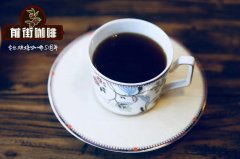Where are the main coffee producing areas in Yemen? the habit of drinking coffee in northern Europe

Professional coffee knowledge exchange more coffee bean information please follow the coffee workshop (Wechat official account cafe_style)
Yemen is located in Ethiopia, across the Red Sea from East Africa, and is the highest quality producer of natural suntan coffee. The coffee produced in Yemen is called mocha beans. In fact, Mocha is an export port of coffee. In the early days, sun beans including nearby East Africa were exported from the port of Mocha to all parts of the world, so the sun beans produced in Ethiopia, including Yemen and East Africa, are collectively referred to as moka beans.
Yemeni coffee grows in steep terrain with little rainfall, poor land and insufficient sunshine. This unique and difficult condition is unfavorable to coffee growth, but it has given birth to the Yemeni mocha, which can not be replaced by the coffee world. The main producing area of Yemeni coffee is Sanani, Matari and Ismaili.
Drinking coffee is not only affected by personal preferences, but also varies from region to region.
Nordic countries (Norway, Sweden ⋯⋯)
Scandinavians are world-famous coffee consumers, who drink mostly drip coffee. In Norway in the 19th century, many people would brew spirits at home. In order to reduce the amount of alcohol people drink, the church chose coffee which is less dangerous than alcohol as a substitute and vigorously promoted it. Since alcohol cannot be distilled at home, many people start drinking coffee, which has become an integral part of daily life in northern Europe.
Turkey
Turkish coffee (also known as "Greek coffee" after it was introduced to Greece) first appeared in the Ottoman Empire in the 16th century and was made from a Turkish coffee pot called "cezve", a long-handle container made of red copper or brass and brewed with coffee powder ground as fine as flour. In the past, people used to pour coffee with another kind of long-handle coffee pot, "ibrik", which has no residue. Because of its similar appearance, later people often confused this pot with cezve. Turkish coffee types include extremely sweet ç ok sekerli, slightly sweet az sekerli, slightly sweet orta and completely unsweet sade. According to tradition, after drinking coffee, people will buckle their cups upside down on the coffee tray and look at the patterns of coffee grounds to predict the future. Only Turkey, the Balkans, the Middle East and eastern Africa drink this coffee; however, people drink not only coffee, but also an art of life.
Important Notice :
前街咖啡 FrontStreet Coffee has moved to new addredd:
FrontStreet Coffee Address: 315,Donghua East Road,GuangZhou
Tel:020 38364473
- Prev

Yemeni coffee flavor characteristics describe American coffee drinking habits Italian coffee drinking habits
Professional coffee knowledge exchange more coffee bean information please follow the coffee workshop (Wechat official account cafe_style) Yemen is located in Asia across the Red Sea and East Africa, Ethiopia, is the highest quality natural sun coffee producer, the coffee produced in Yemen is called mocha beans, in fact Mocha is a coffee export port, including nearby East Africa sun beans from the early days
- Next

Yemeni Matali's flavor describes the Japanese habit of drinking coffee. Ethiopians drink coffee.
Professional coffee knowledge exchange more coffee bean information please follow the coffee workshop (Wechat official account cafe_style) Yemen is located in Asia across the Red Sea and East Africa, Ethiopia, is the highest quality natural sun coffee producer, the coffee produced in Yemen is called mocha beans, in fact Mocha is a coffee export port, including nearby East Africa sun beans from the early days
Related
- Beginners will see the "Coffee pull flower" guide!
- What is the difference between ice blog purified milk and ordinary milk coffee?
- Why is the Philippines the largest producer of crops in Liberia?
- For coffee extraction, should the fine powder be retained?
- How does extracted espresso fill pressed powder? How much strength does it take to press the powder?
- How to make jasmine cold extract coffee? Is the jasmine + latte good?
- Will this little toy really make the coffee taste better? How does Lily Drip affect coffee extraction?
- Will the action of slapping the filter cup also affect coffee extraction?
- What's the difference between powder-to-water ratio and powder-to-liquid ratio?
- What is the Ethiopian local species? What does it have to do with Heirloom native species?

